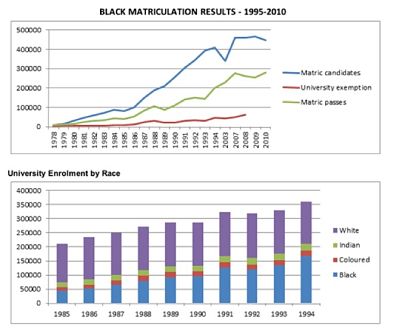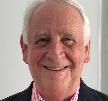BACK TO SCHOOL, MR DEPUTY-PRESIDENT?
In his address on 15 October 2015 to the Higher Education Transformation Summit in Durban, Deputy President Ramaphosa made the following statement:
“Though we have made a decisive shift from the fragmented, inefficient and inequitable higher education system of the apartheid era, we still feel its effects. Had the apartheid rulers not been so thorough, so methodical, so malevolent in the denial of education to the black majority, then South Africa would today be on a completely different developmental trajectory. We would be a more equitable nation, a more prosperous nation. We would have an advanced, diversified, more inclusive economy.”
ANC leaders, can - and do - say whatever they like about the pre-1994 South Africa. From time to time - and however politically incorrect it might be - we should perhaps stop and consider what actually happened.
During the early 80s there was in fact a substantial change in the approach to black education - including a commitment to parity and uniformity in standards and facilities. The reforms were largely prompted by the commission of experts under the leadership of Prof JP de Lange, rector of the Rand Afrikaans University, appointed by the government in 1980 to conduct an in-depth investigation into all aspects of education in South Africa. The Commission’s main report, based on the research work of 18 committees and released in October 1981, was generally regarded as a blueprint for a new deal in education - even though it continued to be based on the unacceptable premise of segregated systems.
In November 1983, the Government accepted most of the Commission’s recommendations. In terms of the National Policy for General Education Act (Act 76 of 1984), the Department of National Education was required to lay down a uniform education policy in respect of norms and standards for syllabuses, examinations, certification of qualifications, running and capital costs of facilities, and salaries and conditions of employment of teaching staff.
The approach was based on the following principles:
- equal opportunities and standards for all, irrespective of race, colour or creed;
- full recognition of the cultural diversity of the population and the common values shared by all;
- a sound relationship between the needs of the individual, society in general and the economic development of the country;
- state responsibility for formal education for all, with due regard to the wishes of individuals, parents and society;
- shared responsibility between the state, and the private sector for non-formal education; and
- state subsidies on an equal basis for private schools.
Policy was formulated in consultation with several advisory bodies and education departments. The advisory bodies included the South African Council for Education which was appointed in October 1985. It made provision for educationists from all population groups to take joint decisions on syllabuses, examinations, conditions of service for teachers; and financing policy in primary and secondary education.
This process led to some substantial reforms.
From 1 December 1986, all teachers at all schools, regardless of race, were paid the same salaries for the same qualifications. (For many years prior to December 1986 white and non-white university staff had been paid the same salaries and qualified for the same fringe benefits).
A 10-year programme was announced in April 1986 to upgrade education programmes and facilities, especially for blacks, Coloureds and Indians, which was budgeted to increase state expenditure on education from R6800 million a year to R10000 million. The programme was designed to improve the qualifications of teachers and the teacher-pupil ratios, and to accommodate the expected massive growth in the number of black pupils.
The Joint Matriculation Board laid down the same standards for matriculation or university entrance for all - although all education departments for all population groups had, in practice, already been using the same core syllabuses for the same subjects for many years.
Two certification councils were established to ensure the equal worth of certificates and diplomas issued by all schools and other educational institutions. One of these was the South African Certification Council, comprising educational experts from all population groups, which issued identical certificates of equal value to pupils of all population groups who passed a given grade or standard at school or technical college. In terms of the legislation all examining bodies had to comply with all the Council’s requirements for examinations for a particular certificate, apply the standards and norms laid down by the Council for these examinations, and introduce the subject matter that was prescribed by the Council for its certificates.
From the early 1980s, all residential universities originally established for whites had been enrolling students of all population groups. By 1987, 11 212 non-white students (3348 Coloured, 3593 Asian and 4271 black) were enrolled at these universities on a full-time or equivalent basis. This represented about 10% of the total. By 1993 they comprised more than 26 000 students, representing 22% of the total - including 34% at UCT and almost 50% at Natal.
A wide range of subjects and courses were offered at secondary schools - requiring at least six subjects in Std. 10, one of which had to be an official language (English or Afrikaans) and one the vernacular language of the pupil.
The syllabuses for Std. 6 to 8 were based on the core syllabuses approved by the Department of Education and Culture of the House of Assembly - which was responsible for white schools. The DEC’s syllabuses were used in Std. 9 and 10. Black matriculants sat for the examinations of the DEC (National Senior Certificate) or that of the Joint Matriculation Board. The core syllabuses were the same for all examining bodies - as was the standard of the Std. 10 examination for all departments.
All this led to substantial improvements in black education outcomes. In 1980 only 29 973 black scholars wrote matric - of whom 15 935 passed. This was, however, less than one-third of the 47 347 white scholars who passed matric in that year. However, in 1994, 410 784 black scholars wrote matric, of whom 201 284 passed. This was more than three times the 60 362 whites who passed matric the same year. By 1995 whites comprised only 37.5% of the students enrolled at our universities – compared with 50.2% for blacks, 5.8% for Coloureds and 6.5% for Indians.
From all of this it emerges that there was, in fact, substantial progress (but never enough) in improving black education - particularly in the period following 1980. The achievement should also be considered against the high levels of unrest among youth during the 1980s - motivated by the slogan “liberation first - education second”.
Does our Deputy President really believe that Prof De Lange - and all those who worked so hard to improve black educational outcomes during the 1980s - were motivated by malevolence?

Source: SAIRR Surveys 1996/97 and 2010/2011
Dave Steward, is Executive Director of the FW de Klerk Foundation

